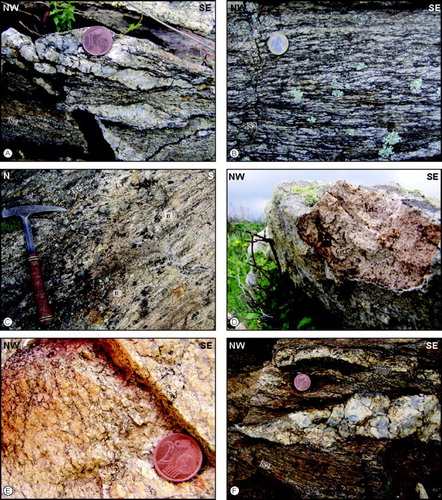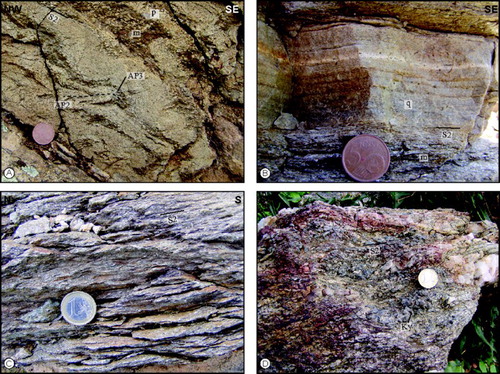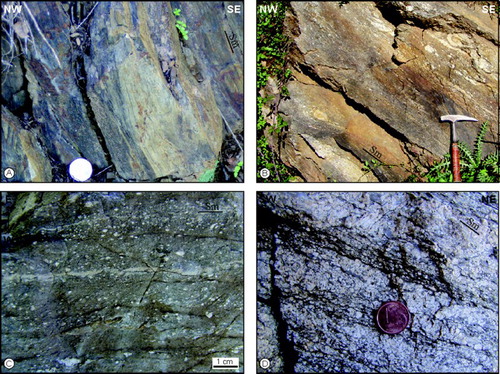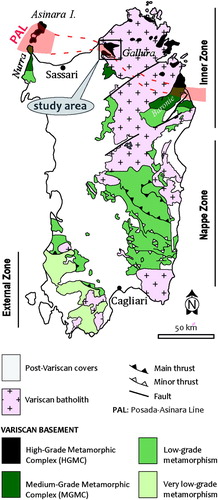Abstract
This study represents the first detailed tectono-metamorphic map of the metamorphic complexes cropping out in the inner portion of the Variscan belt in north-central Sardinia Island (Italy). The Main Map is at a 1:30.000 scale and covers an area of c. 148 km2. It is based on 1: 10.000 scale classic field mapping and represents an overview of the lithological and structural complexities documented in the metasedimentary and migmatite domes cropping out along the central transect of the Posada-Asinara Line (PAL). The PAL is a crustal scale discontinuity that divides migmatites from the metasedimentary sequences affected by greenschist- to amphibolite-facies metamorphism. The map shows the orientations of the superimposed foliations, fold axes and mineral lineations on the basis of geometric crosscutting relationships and, for the first time, the location of ductile-brittle and brittle shear zones developed during the long-lived activity of the Posada-Asinara Line.
1. Introduction
Because of the slightly occurrence of the alpine overprinting, the Sardinia represents a key place where investigate the original architecture of the South European Variscan belt achieved during the Lower Carboniferous age continental collision between Armorica and Gondwana plates (CitationCarmignani et al., 1994 and references therein; CitationCarosi et al., 2005).
From south to north the Variscan belt in Sardinia is classically divided into (): (1) the External zone (i.e. the foreland of the belt). It is represented by Upper Precambrian – Lower Carboniferous sedimentary sequences affected by a very low-grade metamorphism; (2) The Nappe zone (i.e. the thrust-and-fold zone). It crops out in the central part of the island and it is made by Lower Cambrian-Devonian volcano-sedimentary sequence affected by thrusts and folds indicating a SW tectonic transport. Mainly on the base of stratigraphy, it is divided from the north-east to the south-west in the Internal and External Nappe Zone (for a complete review see CitationCarmignani et al., 2001) (3) The Axial (or Inner) zone. It crops out in the north of the island and represents the roots of the chain. It consists of two metamorphic complexes: the High-Grade Metamorphic Complex (HGMC) and the Medium- to Low-Grade Metamorphic Complex (L-MGMC). The former, cropping out in the north-eastern sectors of the island, is made by migmatites derived from Ordovician magmatic and metasedimentary protholiths, associated to metre to decimetre-thick lenses of eclogite and granulite (CitationCruciani et al., 2008a, Citation2008b; CitationFranceschelli et al., 2002; CitationGiacomini et al., 2006). The L-MGMC consists of a sedimentary sequence affected by a prograde Barrovian metamorphism, classically related to the collisional event, that increased towards northeast from the biotite up to the kyanite + biotite zone (CitationFranceschelli et al., 2005 with references therein). A km-thick mylonitic belt, named Posada-Asinara Line (PAL in ; CitationCappelli et al., 1992; CitationElter et al., 1990) marked the boundary between the HGMC and the L-MGMC.
Since the early 1990s the presence along the PAL of amphibolites with eclogite-facies relicts with N-MORB affinity led CitationCappelli et al. (1992) and CitationCarmignani et al., (1994) to suggest the existence of a palaeoocean between the HGMC (i.e. the Armorica plate) and the L-MGMC (i.e. the Gondwana plate). However, recent geochemical and petrographical data (e.g. CitationCruciani et al., 2010; CitationGiacomini et al., 2006) suggest that most of amphibolites cropping out along the PAL could represent a mature stage of the rifting event that produced the opening of the periferical extensional basin (Protothetys) and the Hun Superterrane, a ribbon-like microplate proposed by CitationStampfli et al., (2002) and CitationVon Raumer et al., (2003).
Whatever it is the geodynamic reconstruction, the mylonites of the PAL show geometry, kinematics and timing of shear activity comparable with those documented on shear zones cropping out in southern Corsica (CitationGiacomini et al., 2008), in the Maures- Esterel massif (e.g. CitationCorsini & Rolland, 2009) and in the External Crystalline Massifs of Western Alps (CitationGuillot & Ménot, 2009). These analogies led CitationCorsini and Rolland (2009) to suggest that the part of Gondwana margin, where those regions were located, was affected by an analogous tectono-metamorphic history related to the activity of a NNE-SSW trending lithosphere-scale shear zone, named East Variscan Shear Zone.
Detailed structural and kinematics studies across the PAL have been classically carried out along two main transects located in the Baronie region (CitationCarosi & Palmeri, 2002; CitationDi Vincenzo et al., 2004), in the east, and in the Nurra-Asinara region (CitationCarosi et al., 2004; CitationCarosi & Oggiano, 2002; CitationIacopini et al., 2008), in the west. More recently particular attention has been focused on the central sector of the PAL cropping out in the SW Gallura region ().
Although in the last 5 years I published the results of my research (structural and metamorphic analyses: CitationCarosi et al., 2009; quartz petrofabric and vorticity measurements: CitationFrassi et al., 2009, geochronological analyses: CitationCarosi et al., 2012) on both national and international peer-reviewed journals, I never presented the detailed original geological map from which the different research lines developed. For this reason, in this work I present the geological map of the metamorphic complexes cropping out in the SW Gallura region, focusing on the location of the mylonites of the Posada-Asinara Line.
2. Methods
The metamorphic rocks cropping out in SW Gallura region, are mapped mainly considering their mineral composition and, where possible, the rocks protholiths. Structural elements documented in the field (i.e. foliation, Sn, fold axes, An, mineral lineation, Ln, shear zone) are represented in the map using a synoptic representation that allows to differentiate chronologically each deformation phase. To highlight their spatial orientation, each family of structural elements recognized in the field is also represented using stereographic projections (differentiate for each metamorphic complex). The Main Map is correlated by a schematic structural map of the Sardinia Island and by geological cross-sections through the boundary between Migmatite Complex (HGMC) and amphibolites-facies metasedimentary sequences (MGMC). Furthermore, I inserted two tables of pictures representing at the mesoscopic scale the different mylonitic fabrics documented along the PAL. The description of mylonitic fabrics is completed by stereographic projections of ductile-brittle and brittle shear planes, mylonitic foliations and stretching lineations measured in the field.
Autonomous Region of Sardinia released the topographic maps at 1:10.000 scale (Carta Tecnica Regionale, Regione Autonoma della Sardegna, UTM ED 1950) used during the fieldwork (carried out during years 2003–2004).
3. The metamorphic complexes in SW Gallura
3.1. Rock lithotypes
Three main metamorphic complexes have been classically described in SW Gallura region (CitationOggiano & Di Pisa, 1992). They crop out as isolated metamorphic domes within the late-Variscan granitoids and the post-Permian vulcanites (for a detailed description of those lithotypes see CitationCarmignani et al., 2001). The HGMC mainly crops out in the northern complex and in the easternmost portion of the southern complex meanwhile the MGMC crops out exclusively in the southern complex.
The northern complex is mainly made by metatexites with thin melanocratic layers around thicker leucosomes ((a) and (b)). Rare diatexites with nebulitic ((c)) and schlieren structures, foliated biotite- and muscovite- bearing granitoids ((e)) (CitationMacera et al., 1989; CitationOggiano & Di Pisa, 1987), augen migmatitic gneisses and garnet-bearing orthogneisses ((d)) have been also documented. Cm-thick pegmatitic veins cross cut the main foliation ((f)). Mylonitic fine-grained gneisses with a sillimanite + muscovite mineral assemblage and centimetre-scale quartz-feldspathic boudins, mylonitic pegmatite veins and mylonitic quartzites crop out in the easternmost sector of the southern complex (CitationCarosi et al., 2009; CitationFrassi et al., 2009). The same mineral assemblage and lithologies have been documented in the small complex cropping out in the north-weastern sector of the study area (i.e. near Badesi village).
Figure 2. Migmatites from the HGMC in the northern metamorphic complex. (a) Metatexite with thin restitic layers around cm-thick leucosome; (b) Typical metatexite; (c) migmatitic showing nebulitic texture (n); (d) garnet-bearing orthogneiss (Grt: garnet); (e) aplitic monzogranite in Tarra Padedda area. It is interpreted as the precursor of the post-Variscan batholith; (f) pegmatitic vein cross cutting the S2 foliation. S2: S2 foliation.

Cm- to dm-thick layers of micaschists, paragneisses ((a)) and quartzites ((b)) with occasionally m-thick lenses of eclogites cropping out in the western portion of the southern complex (i.e. L-MGMC). They recorded metamorphic conditions that increases moving towards E/NE from greenschist- to amphibolite-facies.
Figure 3. Metasediments affected by greenschist- to amphibolites facies metamorphism from the MGMC cropping out in the western portion of the southern metamorphic complex. (a) cm-thick layers of micaschists (m) and quartz-rich psammites (p) deformed by F2 and F3 folds. AP2: F2 folds axial plane; AP3: F3 fold axial plane; (b) quartzites (q) (m: micaschist); (c) fine-grained micaschist; (d) Kyanite + staurolite + garnet-bearing micaschist cropping out west of phyllonites (Ky: kyanite). S2: S2 foliation.

The transition between fine-grained gneisses, belonging to the HGMC, and the metasedimentary sequences of the MGMC, occur thought a sequence of mylonitic rocks (highlighting the PAL) developed during different strain, kinematic and metamorphic conditions.
3.2. Tectono-metamorphic history
The three metamorphic complexes were affected by four contractional deformational phases followed by later extensional tectonics. The last event produced F5 folds and both high- and low-angle normal faults (CitationCarosi et al., 2009). D1 deformation phase is documented by S1 foliation, preserved inside D2 microlithons and F2 fold hinges, and by rare centimetre-scale isoclinal F1 folds. D2 deformation phase produced the main structures described in the field. It is documented by chevron to isoclinal F2 folds ((a)), L2 mineral lineation, S2 foliation (that represents the main planar element recognized in each metamorphic complex) and by SC / SC’ mylonitic foliation ((c) and (d)) (see section 3.3 for a complete description of D2 shear zones). The D2 structural elements show a main NW – SE orientation in all the metamorphic complexes. More in detail, in the MGMC their orientations show a sigmoidal trend in map view, varying from NW–SE to NNW – SSE to NW – SE again moving from W to the E. S2 foliation shows a variable dip, both towards the SW and NE, but becomes steeper approaching the phyllonites where it dips towards the NE. The F2 fold axes and L2 mineral lineations usually plunge less than 25° mainly towards the NW. D3 deformation phase produced mainly F3 folds with NW-SE trending axes and sub-vertical axial plane that have kink and chevron geometry. Finally N-S trending F4 folds, with kink and box geometry deformed previous structures.
The presence of shallow dipping L2 object lineation parallel to the F2 fold axis and to the main trend of the belt and the presence of D2 shear domains suggest that large part of exhumation of the high-grade metamorphic rocks (HGMC) occurred during an important transpressive regime started since the post-collisional D2 deformation phase (CitationCarosi et al., 2009; CitationFrassi et al., 2009).
Microstructural data carried out on the metasedimentary sequences of the MGMC suggest that the Barrovian mineral assemblage (Bt + Grt + St + Ky) grew from syn-/late-D1 to the initial stage of the D2 deformation phase (mineral abbreviations after CitationKretz, 1983). Mineral chemistry carried out on garnet and plagioclase constraint the initial stages of metamorphic growth (produced during the continental collision) between both temperature and pressure peaks (P= 0.9–1.1 GPa and T=600–650°C; CitationFrassi, 2006). Temperature of c. 450–550°C and P of c. 0.3–0.6 GPa constraint the late syn-D2 metamorphic growth (CitationFrassi, 2006).
In the HGMC, a leucosomes – melanosome layering highlights the S2 foliation. Quartz, plagioclase with mechanical twins, and rarely K-feldspar, constitute the leucosomes, whereas biotite, muscovite and relicts of zoisite, garnet and plagioclase define the melanosomes. Quartz crystals present a strong crystal preferred orientation and polygonal shape whereas biotite, muscovite and garnet are often replaced by anisotropic flakes of fibrolite and by chlorite + rutile intergrowths. Sillimanite, documented in the HGMC cropping out east of the phyllonitic belt and classically related to the prograde collisional metamorphic blastesis, grew from syn- to post-D2 (CitationCarosi et al., 2005, Citation2009; CitationFrassi et al., 2009).
3.3. Mylonites from the Posada-Asinara Line
Two shear zone systems showing opposite sense of shear and a NW-SE trend are reported by CitationCarosi et al. (2009, Citation2012) and CitationFrassi et al. (2009). There are in detail: (1) a sinistral top-to-the NW shear belt developed within the fine-grained gneisses and/or micaschists cropping out in the easternmost section of the southern complex (e.g. east of Giagazzu village) and in the small complex located south of Badesi village (i.e. the HGMC). They developed during the D2 post-collisional deformation phase. (2) a dextral top-to-the SE shear belt that produced with time: (a) ductile and brittle-ductile D2 mylonites ((c) and (d)), developed within the garnet – plagioclase ± kyanite ± staurolite – bearing metasedimentary sequences (i.e. the MGMC) in the southern complex (e.g. Giagazzu area); (b) high-strain phyllonites (marking the boundary between MGMC and HGMC; (a)) and low-strain phyllonites ((b) and (c)). The difference between high- and low-strain phyllonites is mainly ascribed to an enrichment of phyllosilicate content during retrogressive mylonitization. Low-strain phyllonites wrap lenses of sinistral mylonites; (c) mm-thick cataclasites, overprinting on both early phyllonites and sinistral mylonites ((d)).
Figure 4. (a) High-strain phyllonites; (b) low-strain phyllonites with c. 15-cm-thick sheared pegmatitic veins; (c) detail of low-strain phyllonites, with mm-size porphyroclasts of feldspar; (d) mylonitic pegmatitic vein deformed by sinistral top-to-the NW shear sense. Sm: mylonitic foliation.

Geometric crosscutting relationships indicate that the D2 sinistral shearing could have began before the dextral kinematics. However, U/Th/Pb isotopic measurements carried out in monazites and zircons constrain the D2 shear activity (both dextral and sinistral shearing) at c. 320 Ma (CitationCarosi et al., 2012). Dextral and sinistral mylonites overprint prograde Barrovian index minerals (garnet, plagioclase, staurolite and kyanite) grew during the collisional stage (CitationFranceschelli et al., 2005 with references therein) whereas sillimanite grew parallel or oblique to the sinistral shear planes testifying its blastesis during the decompressive path that produced the exhumation of migmatitic rocks (see CitationCarosi et al., 2009 for more details; CitationCruciani et al., 2008a).
According to CitationFrassi et al. (2009) deformation within both the sinistral and dextral shear zones involved general non-coaxial flow with a contemporaneous contribution of pure and simple shear. More in detail, the transpressional deformation produced initially sinistral mylonites under a simple-shear-dominated regime (vorticity of flow = 0.68–0.88) and subsequently dextral mylonites during a pure-shear-dominate regime (vorticity of flow = 0.53–0.70). Microstructural and quartz c-axis petrofabric results additionally constrained the shearing activity under deformation temperatures ranging from 350–550° up to 450–600°C for the dextral and sinistral shear belt respectively (CitationFrassi et al, 2009).
Geometric considerations point to a minimum vertical exhumation of c. 3.4–4.2 km and c. 15–20 km for the sinistral and dextral shear zones respectively (CitationFrassi et al., 2009). The temporal variation in kinematics, flow type and strain geometry may be produced by a change in the regional stress field caused by the rotation of the convergence direction during continental collision (CitationFrassi et al., 2009) during the earlier stages of the East Variscan Shear zone.
4. Accuracy and completeness of the map
The fieldwork was performed using a 1:10.000 scale topographic map. To document the geometric and temporal relationship between brittle, brittle-ductile and ductile mylonites of the Posada-Asinara Line, enlarged map reaching 1:5.000 scale have been used during the fieldwork in the southern metamorphic complex.
No geological mapping has been carried out in the Permian vulcanites. For this reason small scale (1.250.000 scale, CitationCarmignani et al., 2001) and geological sketch map previously published in extant literature (CitationOggiano & Di Pisa, 1992) has been used to complete the map area comprised between the metamorphic complexes. However, to emphasize the structures and complexities of the metamorphic complexes no differentiations have been mapped in vulcanites and quaternary covers.
5. Conclusions
This study represents the first detailed tectono-metamorphic map of the metamorphic complexes cropping out in the inner portion of the Variscan belt in north-central Sardinia Island (Italy). The map is based on 1: 10.000 scale classic field mapping and represents an overview of the lithological and structural complexities present in the metasedimentary and migmatitic domes cropping out in south-western Gallura region. It pays particular attention on the spatial and temporal partition of the mylonitic fabrics, cropping out in the central sector of the Posada-Asinara Line that was active at different time and at different structural levels during the exhumation of the Migmatite Complex.
Software
Both topography and geological features have been drawn using Canvas X. Stereonet plots were produced using the ‘old’ free software StereoPlot by Neil Mancktelow.
Main Map: Structural Map of Metamorphic Complexes in SW Gallura Region (Northern Sardinia, Italy)
Download PDF (13.2 MB)Acknowledgements
I thank Giedrė Beconytė for its comments on the map and Elena Druguet and Marcello Franceschelli for their detailed comments on both the manuscript and the map. I also thank Michele Zucali for editorial handling. Thank R. Carosi for financial support during the field work.
References
- Cappelli, B., Carmignani, L., Castorina, F., Di Pisa, A., Oggiano, G., & Petrini, R. (1992). A Hercynian suture zone in Sardinia: Geological and geochemical evidences. Geodinamica Acta (Paris), 5, 101–118.
- Carmignani, L., Carosi, R., Di Pisa, A., Gattiglio, G., Musumeci, G., Oggiano, G., & Pertusati, P. (1994). ‘The Hercynian chain in Sardinia (Italy). Geodinamica Acta, 7(1), 31–47.
- Carmignani, L., Oggiano, G., Funedda, A., Conti, P., Pasci, S., & Barca, S. (2001). Carta Geologica della Sardegna in scala 1:250.000. Firenze: Litografica Artistica Cartografica.
- Carosi, R., Di Pisa, A., Iacopini, D., Montomoli, C., & Oggiano, G. (2004). The structural evolution of the Asinara Island (NW Sardinia, Italy). Geodinamica Acta, 17, 309–329. doi: 10.3166/ga.17.309-329
- Carosi, R., Frassi, C., Iacopini, D., & Montomoli, C. (2005). Post collisional transpressive tectonics in northern Sardinia (Italy). In R. Carosi, R. Dias, D. Iacopini, & G. Rosenbaum (Eds.), The Southern Variscan Belt. Journal of the Virtual Explorer, Vol. 19. Paper 3.
- Carosi, R., Frassi, C., & Montomoli, C. (2009). Deformation during exhumation of medium- and high-grade metamorphic rocks in the Variscan chain in northern Sardinia (Italy). Geological Journal, 44, 280–305. doi:10.1002/gj.1137
- Carosi, R., Montomoli, C., Tiepolo, M., & Frassi, C. (2012). Geochronological constraints of early post-collisional exhumation of Variscan high-grade metamorphic rocks of northern Sardinia (Italy). Terra Nova, 24, 42–51. doi:10.1111/j.1365-3121.2011.01035.x
- Carosi, R., & Oggiano, G. (2002). Structural evolution of North eastern Sardinia: Insight on the tectonic evolution of the Variscan Belt. C.R. Geoscience, 334, 287–294. doi:10.1016/S1631-0713(02)01740-6
- Carosi, R., & Palmeri, R. (2002). Orogen-parallel tectonic transport in the Variscan belt of northeastern Sardinia (Italy): Implications for the exhumation of medium-pressure metamorphic rocks. Geological Magazine, 139, 497–511. doi:10.1017/S0016756802006763
- Corsini, M., & Rolland, Y. (2009). Late evolution of the southern European Variscan belt: Exhumation of the lower crust in a context of oblique convergence. Comptes Rendus Geosciences, 341, 214–223. doi: 10.1016/j.crte.2008.12.002
- Cruciani, G., Dini, A., Franceschelli, M., Puxeddu, M., & Utzeri, D. (2010). Metabasite from the Variscan belt in NE Sardinia, Italy: Within-plate OIB-like melts with very high Sr and low Nd isotope ratios. European Journal of Mineralogy, 22, 509–523. doi: 10.1127/0935-1221/2010/0022-2042
- Cruciani, G., Franceschelli, M., Elter, F., Puxeddu, M., & Utzeri, D. (2008a). Petrogenesis of Al–silicatebearing trondhjemitic migmatites from NE Sardinia, Italy. Lithos, 102(3–4), 554–574.
- Cruciani, G., Franceschelli, M., Jung, S., Puxeddu, M., & Utzeri, D. (2008b). Amphibole-bearing migmatites from the Variscan Belt of NE Sardinia, Italy: Partial melting of mid-Ordovician igneous sources. Lithos, 105(3–4), 208–224.
- Di Vincenzo, G., Carosi, R., & Palmeri, R. (2004). The relationship between tectono-metamorphic evolution and argon isotope records in white mica: Constraints from in situ 40Ar-39Ar laser analysis of the Variscan basement of Sardinia. Journal of Petrology, 45, 1013–1043. doi:10.1093/petrology/egh002
- Elter, F. M., Musumeci, G., & Pertusati, P. C. (1990). Late Hercynian shear zones in Sardinia. Tectonophysics, 176, 387–404. doi:10.1016/j.bbr.2011.03.031
- Franceschelli, M., Carcangiu, G., Caredda, A., Cruciani, G., Memmi, I., & Zucca, M. (2002). Transformation of cumulate mafic rocks to granulite and re-equilibration in amphibolite and greenschist facies in NE Sardinia, Italy. Lithos, 63(1–2), 1–18.
- Franceschelli, M., Puxeddu, M., & Cruciani, G. (2005). Variscan metamorphism in Sardinia, Italy: Review and discussion. In R. Carosi, R. Dias, D. Iacopini, & G. Rosenbaum (Eds.), The Southern Variscan Belt. Journal of the Virtual Explorer, Vol. 19. Paper 2.
- Frassi, C. (2006). The Badesi-Li Paùlis shear zones in the inner zone of the Variscan belt in Sardinia (Italy): structural analysis and regional implications (Ph.D Thesis). University of Pisa.
- Frassi, C., Carosi, R., Montomoli, C., & Law, R. D. (2009). Kinematics and vorticity of flow associated with post-collisional oblique transpression in the Variscan Inner Zone of northern Sardinia (Italy). Journal of Structural Geology, 31, 1458–1471. doi:10.1016/j.jsg.2009.10.001
- Giacomini, F., Bomparola, R. M., Ghezzo, C., & Guldbransen, H. (2006). The geodynamic evolution of the Southern European Variscides: Constraints from the U-Pb geochronology and geochemistry of the lower Palaeozoic magmatic-sedimentary sequences of Sardinia (Italy). Contributions to Mineralogy and Petrology, 152, 19–42. doi: 10.1007/s00410-006-0092-5
- Giacomini, F., Dallai, L., Carminati, E., Tiepolo, M., & Ghezzo, C. (2008). Exhumation of a Variscan orogenic complex: Insights from the composite granulitic-amphibolitic metamorphic basement of South-East Corsica (France). Journal of Metamorphic Geology, 26, 403–436. doi: 10.1111/j.1525-1314.2008.00768.x
- Guillot, S., & Ménot, R. P. (2009). Paleozoic evolution of the Extern Crystalline Massifs of the Western Alps. C.R. Geosciences, 341, 253–265. doi: 10.1016/j.crte.2008.11.010
- Iacopini, D., Carosi, R., Montomoli, C., & Passchier, C. W. (2008). Strain analysis and vorticity of flow in the northern Sardinian Variscan belt: Recognition of a partitioned oblique deformation event. Tectonophysics, 365, 7–22.
- Kretz, R. (1983). Symbols for rock-forming minerals. American Mineralogist, 68, 277–279.
- Macera, P., Ponticelli, S., Del Moro, A., Di Pisa, A., Oggiano, G., & Squadrone, A. (1989). Geochemistry and Rb/Sr of syn-tectonic peraluminous granites of Western Gallura, northern Sardinia: Constraints on their genesis. Periodico di Mineralogia, 58, 25–43.
- Oggiano, G., & Di Pisa, A., (1987). I graniti peralluminosi sin-tettonici nell'area Aggius-Trinitrà D'Agultu e loro rapporti con le metamorfiti di alto grado della Bassa Gallura (Sardegna settentrionale). Bollettino della Società Geologica Italiana, 113, 105–115.
- Oggiano, G., & Di Pisa, A. (1992). Geologia della catena Ercinica in Sardegna – Zona Assiale. In L. Carmignani, P. C. Pertusati, S. Barca, R. Carosi, A. Di Pisa, M. Gattiglio, G. Musumeci, & G. Oggiano (Eds.), Struttura della catena ercinica in Sardegna. Guida all'escursione (pp. 147–177). Siena: Gruppo Informale di Geologia Strutturale.
- Stampfli, G. M., Von Raumer, L. F., & Borel, G. D. (2002). Paleozoic evolution of pre-Variscan terranes: Form Gondwana to the Variscan collision. Geological Society of America Special Paper, 364, 263–280.
- Von Raumer, J. F., Stampfli, G. M., & Bussy, F. (2003). Gondwana-derived microcontinets – The constituents of the Variscan and Alpine collisional orogens. Tectonophysics, 365, 7–22. doi: 10.1016/S0040-1951(03)00015-5

